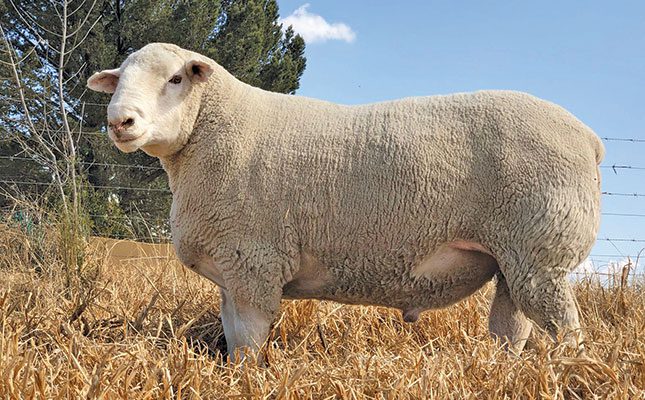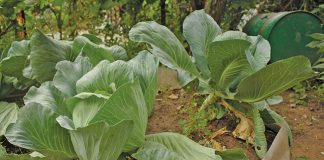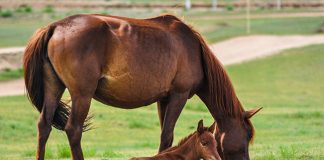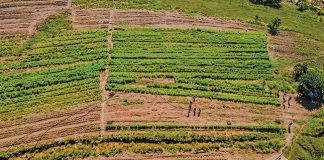
A few years ago, when South Africa was struck by an outbreak of cryptosporidiosis, a leading cause of diarrhoea in sheep, Johan Barnard was forced to rebuild his stud, Johanri Dormers. As a result, he now runs a lucrative operation producing top-class animals.
This is evident in the number of Johanri animals that achieved South African record
prices at the 4×4 Dormer Auction held live in Bethlehem, Free State, and online earlier last year. Not only did Barnard’s ram ‘Spiekeries’ JB 20 0099 achieve the highest price ever paid for a Dormer ram in the country when it sold for R510 000, but his ewe JB 20 0034 sold for R180 000, the highest price ever paid for a ewe in South Africa.
In addition, the Johanri ram ‘Sniper’ JB 20 0091 achieved the second-highest price at the auction, selling for R200 000, while a commercial Johanri ewe sold for R22 500 and a parcel of five in-lamb commercial ewes sold for R50 000. Johanri stud rams sold for an average price of R85 545, while stud ewes averaged R84 062.
Trial by fire
Barnard started his Dormer stud in 2005 with 50 ewes. “It was an uphill battle in the beginning. I was a young breeder who lacked experience, but I forged ahead, often achieving the best or second-best prices at the national Dormer auctions.
“And then in 2013 the disastrous cryptosporidiosis outbreak struck. Nobody knew to what extent the animals could be affected and how long the outbreak would last,” says Barnard.
As a result of the outbreak, he had no choice but to sell his entire stud in 2017.
“Many breeders were affected by the outbreak, and I was afraid that the market would become flooded and that the animals would lose all value,” he recalls.
He had, however, kept a few embryos, and still had semen from Johanri’s top-performing rams over the years. With this genetic reservoir and a handful of ewes, he started his stud anew by means of embryo flushing.
Since then, Johanri Dormers has gone from strength to strength, which Barnard puts down to the enforcement of select line-breeding criteria. He describes line breeding as a technique used to exploit certain genetic traits within a family line.
Line breeding, according to him, is a system in which the relationship between the breeding animals is not as close as it is in inbreeding, and is usually aimed at retaining highly prized genetics in the flock. It is usually limited to mating cousins or even half-siblings.
By contrast, outbreeding or outcrossing is the mating of animals of the same breed that are four to six generations apart; in other words, those that are not closely related.
The term crossbreeding refers to the mating of animals of different breeds to develop new ones, such as the Dohne Merino.
Unique phenotype
“The Johanri Dormers were phenotypically unique, and I chose to implement line breeding in order to retain these characteristics. And while I can’t ascribe the stud’s success solely to line breeding, it did establish the foundation of success. This includes the rams’ exceptionally intense prepotency, as well as the specific phenotypical features of the animals in the stud.
“I would, nonetheless, warn against long-term line breeding. The introduction of new genetics from time to time is obviously required to retain the genetic integrity of the flock,” explains Barnard.
Spiekeries is a product of line breeding and, according to Barnard, is “one in a million” and “the ideal package”. This ram is extraordinarily robust, with a very strong head, well-developed legs, a perfect topline, and an unequalled hind quarter. Barnard says the animal has a near-perfect build and incomparable breeding values.
Truly South African
The Dormer was developed in South Africa by crossbreeding Dorset Horn rams with German Merino ewes. This was a result of a project started in 1927 at the Elsenburg research farm in Stellenbosch.
Crossbred animals are known for their remarkable hybrid vigour. Thus, the aim
of the project was to produce a mutton breed with rams suitable for crossbreeding, and slaughter lambs that could grow out rapidly and economically in the country’s cold and wet winter rainfall areas.
The Dormer Sheep Breeders’ Society of South Africa was formed in October 1965, and in April 1970, SA Stud Book recognised the Dormer as a developing sheep breed.
Careful management
Barnard warns that if line breeding is not managed carefully, it can result in impaired reproduction, slower growth, reduced resistance to diseases, and other issues. It can also increase the frequency of abnormalities in a stud.
“Line breeding requires the use of the genes of a specific ram or bull in order to concentrate the animal’s physical characteristics in a particular bloodline.
“Take Bonsmara cattle, for example: to this day, Bonsmara breeders refer to the ‘Edelheer line’. The legendary Edelheer was one of the original bulls used in the development of the indigenous Bonsmara [breed],” he explains.
Barnard says he was obliged to follow a line-breeding programme in 2006, as he didn’t have the money to buy a new stud sire at the time.
He adds that his eyes were opened to the benefits of line breeding, as the progeny were of outstanding quality and formed the basis of the Johanri stud as it is known today.
Performance data vs balance
When it comes to animal selection, Barnard advises against overaccentuating performance data. He explains that while such information is valuable, it is not more important than the actual constitution of a breeding animal.
He stresses the importance of balance, and says he is concerned that some breeders pay too much attention to performance data and that the phenotypical characteristics of the animals are falling by the wayside.
“Balance is key. It doesn’t make sense to blindly chase top performance statistics to the detriment of an animal’s growth, phenotype and fertility.
“An animal should be seen as a whole, without too much focus on a single trait. For instance, too much emphasis on growth could result in a late-maturing animal that suffers from poor fertility.
“It troubles me that prospective buyers are sometimes too keen to select breeding material based solely on performance data, without having sound knowledge of the correct constitution and phenotypical attributes required in a top-performing animal,” says Barnard.
Artificial insemination
Although artificial insemination (AI) played a decisive role in the rebuilding of the Johanri stud, Barnard shies away from any form of AI that necessitates the use of hormones in preparation for insemination.
According to him, the continuous use of hormones has a markedly negative impact on ewes’ fertility levels in the long run.
Hormones are used in laparoscopic AI, which is therefore only used in highly exceptional cases, such as cases where the semen of a ram that has died is used.
Robust and strong
Barnard is passionate about the Dormer, describing it as the most beautiful sheep breed in the world and with outstanding maternal traits.
In addition, these hardy and highly adaptable non-selective grazers are ideally suited to extensive farming conditions. His animals are kept on sourveld.
“The typical Johanri Dormer is a strong, full-bodied animal that excels under challenging conditions. Here at Lindley, the average annual rainfall is 650mm, and temperatures range from -10°C to 35°C. Despite the often-adverse conditions, we still maintain a 183% lambing rate,” he says with pride.
The ewes’ feed is supplemented with maintenance licks throughout the year. Three weeks before the mating season kicks off, they are supplied with a flush lick until four weeks after mating.
The pregnant ewes lamb on fields planted to oats. After weaning, the lambs are kept on a growth ration for one month, and are then moved to natural grazing supplemented with a protein lick.
The weaned rams are once again put on a growth ration from six months of age, and this is gradually increased as they get older.
Email Johan Barnard at [email protected].











